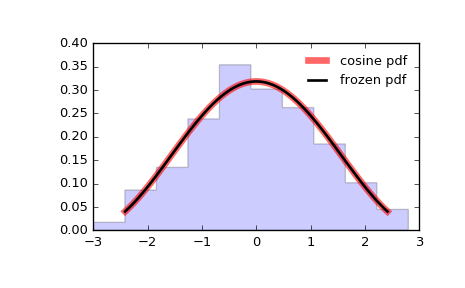scipy.stats.cosine¶
- scipy.stats.cosine = <scipy.stats._continuous_distns.cosine_gen object at 0x2b2318bf6d10>[source]¶
A cosine continuous random variable.
As an instance of the rv_continuous class, cosine object inherits from it a collection of generic methods (see below for the full list), and completes them with details specific for this particular distribution.
Notes
The cosine distribution is an approximation to the normal distribution. The probability density function for cosine is:
cosine.pdf(x) = 1/(2*pi) * (1+cos(x))
for -pi <= x <= pi.
The probability density above is defined in the “standardized” form. To shift and/or scale the distribution use the loc and scale parameters. Specifically, cosine.pdf(x, loc, scale) is identically equivalent to cosine.pdf(y) / scale with y = (x - loc) / scale.
Examples
>>> from scipy.stats import cosine >>> import matplotlib.pyplot as plt >>> fig, ax = plt.subplots(1, 1)
Calculate a few first moments:
>>> mean, var, skew, kurt = cosine.stats(moments='mvsk')
Display the probability density function (pdf):
>>> x = np.linspace(cosine.ppf(0.01), ... cosine.ppf(0.99), 100) >>> ax.plot(x, cosine.pdf(x), ... 'r-', lw=5, alpha=0.6, label='cosine pdf')
Alternatively, the distribution object can be called (as a function) to fix the shape, location and scale parameters. This returns a “frozen” RV object holding the given parameters fixed.
Freeze the distribution and display the frozen pdf:
>>> rv = cosine() >>> ax.plot(x, rv.pdf(x), 'k-', lw=2, label='frozen pdf')
Check accuracy of cdf and ppf:
>>> vals = cosine.ppf([0.001, 0.5, 0.999]) >>> np.allclose([0.001, 0.5, 0.999], cosine.cdf(vals)) True
Generate random numbers:
>>> r = cosine.rvs(size=1000)
And compare the histogram:
>>> ax.hist(r, normed=True, histtype='stepfilled', alpha=0.2) >>> ax.legend(loc='best', frameon=False) >>> plt.show()

Methods
rvs(loc=0, scale=1, size=1, random_state=None) Random variates. pdf(x, loc=0, scale=1) Probability density function. logpdf(x, loc=0, scale=1) Log of the probability density function. cdf(x, loc=0, scale=1) Cumulative distribution function. logcdf(x, loc=0, scale=1) Log of the cumulative distribution function. sf(x, loc=0, scale=1) Survival function (also defined as 1 - cdf, but sf is sometimes more accurate). logsf(x, loc=0, scale=1) Log of the survival function. ppf(q, loc=0, scale=1) Percent point function (inverse of cdf — percentiles). isf(q, loc=0, scale=1) Inverse survival function (inverse of sf). moment(n, loc=0, scale=1) Non-central moment of order n stats(loc=0, scale=1, moments='mv') Mean(‘m’), variance(‘v’), skew(‘s’), and/or kurtosis(‘k’). entropy(loc=0, scale=1) (Differential) entropy of the RV. fit(data, loc=0, scale=1) Parameter estimates for generic data. expect(func, args=(), loc=0, scale=1, lb=None, ub=None, conditional=False, **kwds) Expected value of a function (of one argument) with respect to the distribution. median(loc=0, scale=1) Median of the distribution. mean(loc=0, scale=1) Mean of the distribution. var(loc=0, scale=1) Variance of the distribution. std(loc=0, scale=1) Standard deviation of the distribution. interval(alpha, loc=0, scale=1) Endpoints of the range that contains alpha percent of the distribution
